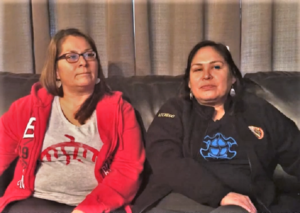Anishinaabe citizen raising funds to help build traditional Roundhouse in community

By Colin Graf
CHIPPEWAS OF THE THAMES FIRST NATION—Betsy Kechego is determined to make her vision of a place for her people to rediscover their cultural roots a reality.
Kechego, also known as Waawaaskone Kiizhigo, and a group of friends and family in Chippewas of the Thames First Nation are launching a new phase of their plan to raise $10,000 to build a lodge resembling the traditional Anishinaabe roundhouse in their community.
“We’ve talked about this for a long time,” says the Ojibwe-language kindergarten teacher, describing the launch of a new online art auction by the “grassroots group” to raise money for the construction of the Nimkii Binesi Zaswaaning (Thunderbirds’ Nest), a building for her people to practise culture and traditions.
The auction, lasting from Feb. 6-Mar. 24, features artwork by well-known First Nation artists such as Christi Belcourt, creator of the Walking with Our Sisters project and the residential schools memorial stained glass in the Parliament buildings, and Isaac Murdoch. Paintings by local artist Alan French along with jewellery, leatherwork, and clothing are also up for bids.
According to Kechego, the roundhouse, holding 100-150 people, with doorways facing east and west in traditional fashion, will be a place where people would come to talk about things in the community, or there would be a celebration, maybe a naming ceremony.
She has drawn inspiration from a similar building, the Manitoba Turtle Lodge in Fort Alexander, Manitoba, and Elder Dave Courchene.
“[It] has been a center for events, ceremonies, conferences, and gatherings of people from around the world to honour the traditional knowledge of the First Peoples,” according to the lodge website.
Kechego says Courchene is encouraging Anishinabe to start building roundhouses “because that was our original gathering place when we wanted to make big decisions about our families and our communities”.
“We would ask for guidance and directions from our Elders and our spiritual connections from our manidoo,” she explains.
In a recording from the roundhouse website, Kechego explains why the site name is perfect for the group’s purpose.
“Thunderbirds bring renewal and new life. Our children will come in and hear what their Elders have to share.”
She is also looking at a roundhouse built at the Mississaugas of New Credit to provide a model for her dream.
“[It is] a space in which the original Anishinabek lifeways, knowledge and education is delivered in the oral and/or customary traditions passed along by Elders and Knowledge Holders,” explains Kechego.
According to the New Credit centre’s website, the building was constructed under the guidance of Elders and Traditional Practitioners to promote education and healing through traditional Indigenous methods, pedagogies and language.
Fundraising for the Chippewas of the Thames project began last summer when over one-thousand-dollars was raised through private auctions at the Forest City Gallery in London. Kechego is hoping discussions planned with Fanshawe College’s First Nations Centre may help provide some labour for the project through the College’s carpentry program.
While the Chippewas of the Thames has a modern community centre, Kechego says her roundhouse is intended for different purposes. She envisions the roundhouse as a place where “decisions about what kind of lifestyle we are going to have, to talk about revitalizations of culture and knowledge and what was lost through residential schools” take place.
Kechego hopes many activities at the roundhouse will centre around teaching and re-learning Anishinaabemowin.
“Our Elders are passing on and their knowledge is going with them,” she says. “I’m pretty scared because in our community we don’t have any Elder fluent (Ojibwe) speakers.”
A language student herself, Kechego hopes adults will take up studying with her, and that a new Ojibwe-immersion program at the community’s elementary school will help keep the language alive in her First Nation.
“Language is where our worldview comes from; it’s very important,” she emphasizes.
The structure could also become a place to pursue reconciliation with the settler community, as Kechego sees it. She believes in possibly inviting others in as cultural tourists, but notes that there is a fine line ensuring visitors come with open minds and aren’t looking for opportunities to exploit or appropriate First Nations’ teachings.
“When you think about the medicine wheel, it’s about people coming together and accepting each other in harmony. If you want to make a difference you have to open the door and let people in.”
Still, Kechego says that community will always come first in her building and a place “where we can reflect on what we need as a community to move forward and also bring back that old knowledge in today’s time”.
“That’s the big question for all First Nations’ people, ‘How do we manage to come out from under the Indian Act?’ We’re saying we want to rebuild our governing systems when we’re hardly even knowing what those systems were,” Kechego says, noting that is due to the erasure of traditional knowledge through the residential schools.
The roundhouse could also provide a place for local youth to learn life teachings.
While she hasn’t asked for endorsement or support from Chief and Council, Kechego says some councillors have made supportive comments.
“Every community should try something along these lines…everybody has their church and that’s great, but let’s also have a place where we can offer our prayers and practise our belief systems.”


